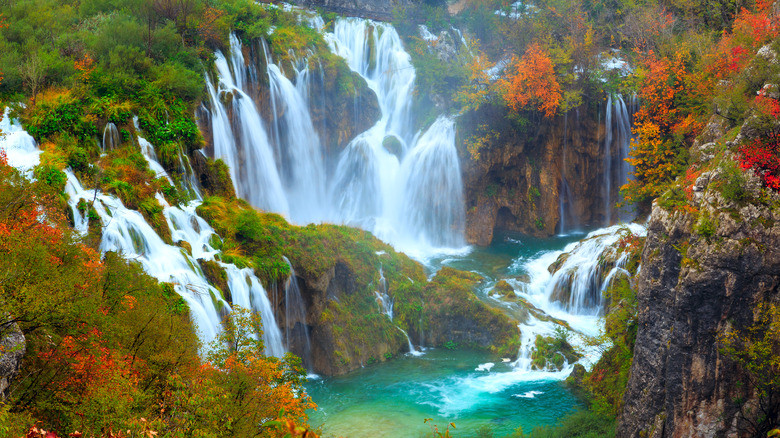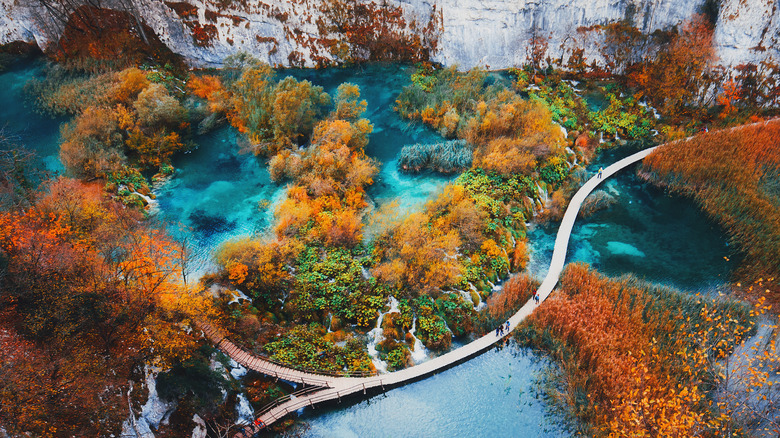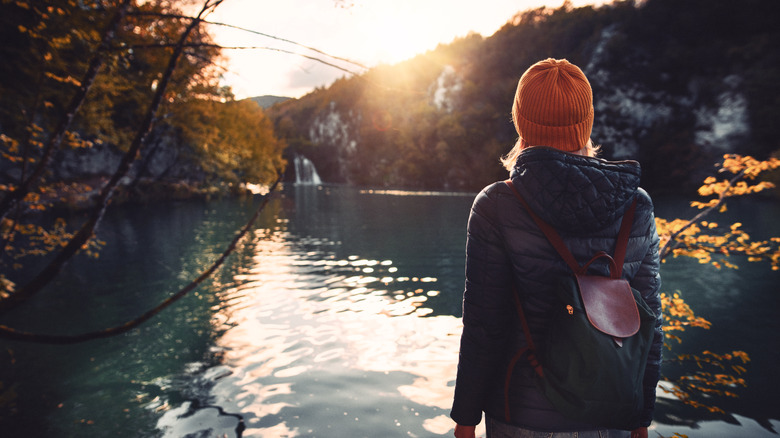Rick Steves Says This European Wonder Is Like Niagara Falls On Top Of The Grand Canyon
Rick Steves excels in identifying Europe's lesser-known gems, describing them so vividly that they leap off the screen and into our imaginations. One of those diamonds is Plitvice Lakes National Park in Croatia, which Steves describes in his blog as a "European Niagara Falls, diced and sprinkled over a heavily forested Grand Canyon." Set in a mountainous part of Croatia near the border of Bosnia and Herzegovina, the most celebrated part of the park has 16 adjoining lakes that flow into one another via a series of waterfalls. The cascades branch in myriad directions due to the intricacy of the underlying karst landscape, giving them a spectacular appearance. Add to that the area's other amazing geological and ecological features, and you understand why Steves views this place as the pinnacle of European wonderlands.
The park has at least 100 caves, some of which feature stalactites, stalagmites, and other cool rock formations. A wide variety of animals live in the park's dense forests, including deer, wolves, wildcats, lynx, brown bear, and more than 160 kinds of birds. The area's striking landscape led to its becoming Croatia's first national park in 1949 and a UNESCO World Heritage site in 1979. The park is also an important historical site, as Steves notes, "On Easter Sunday in 1991, the first shots of Croatia's war of independence from Yugoslavia were fired in this park."
Yet somehow among Americans, Steves says, Plitvice Lakes remains relatively unknown.
Wonders await in Plitvice
The best way to explore Plitvice Lakes is to stroll along the boardwalks, from which you'll have beautiful lakeside views. The raised wooden pathways weave through the forest, past heart-stoppingly gorgeous waterfalls and the Šupljara cave, and between the colorful lakes, which Steves observes are brimming with trout. One of the park's highlights that you can see from the boardwalks is Croatia's tallest waterfall, Veliki Slap, which is 256 feet high. To get out on the water for a different vantage point, visitors can rent rowboats or ride electric boats on Kozjak Lake, which is the park's largest. Hiking is another great option for those wanting to explore beyond the park's lakes and waterfalls and into its forests, meadows, and mountains.
After a few hours of walking through the misty paradise that is Plitvice Lakes, you'll probably have worked up an appetite. Steves suggests heading to one of the park's restaurants to grab a meal and reflect on your magical journey before departing for your next destination. The park has a few different eateries to choose from, like Lička Kuća, which looks and feels like a traditional Croatian mountain house. The cozy establishment serves a range of hearty local dishes, but if you're like Steves, you'll be ordering the grilled trout, freshly caught in one of the nearby lakes.
Getting to and staying at Plitvice Lakes
The best way to reach Plitvice Lakes is via a private vehicle or bus from Zagreb, which is around 81 miles northeast of the park. From the main bus station in Zagreb, there are a number of daily buses to the park. Given the reasonable one-way travel time (2.3 hours) and the frequency of buses between the two places, a day trip to Plitvice is entirely doable. The other option is to arrange a tour from Zagreb or another nearby city, in which case transportation will be arranged for you.
If you are interested in staying in the area, there are numerous hotels and guest houses in and around the park. Additionally, there are two designated camp sites within the park that offer visitors the opportunity to pitch their own tent, park a campervan, or rent a rustic bungalow. Both campsites also have nearby restaurants for visitors who don't want to bring in their own food. When planning a trip to stay at Plitvice Lakes, make sure to review the accommodation options beforehand, as some only offer seasonal availability.


